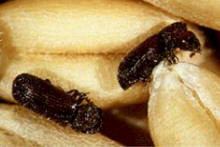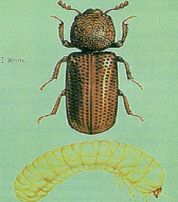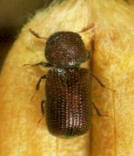

Laid in clusters as females actively bore through grains. Eggs are
laid outside the kernel and young larvae bore into the grain to complete
their development.
complete
their development.
Larvae:
The cream coloured larvae have biting mouthparts and three pairs of
legs. The young larvae are mobile but become immobile as they complete
their development concealed within grain or flour
Pupae:
The mature fourth instar enters into an inactive pupal stage within
the grain and gradually assumes the form of the adult.
Adult:
When the pupal stage is completed the newly formed adult emerges
from the grain by chewing through the outer grain layers. The adult
beetle is long lived and is a strong flier when conditions are warm.
- All dust collections of walls, framework and floors should be cleared up and a suitable pesticide applied to these areas.
- Pallets should always be used to store finished products and ample space should be allowed to visually inspect the goods on a regular basis.
- Systematic de-infestation of pallets should be carried out regularly. Once again, only approved pesticides can be used for this purpose.
- Cooling stored grain through aeration

- Treating grain with an insecticide powder such as Dryacide® or liquid residual chemicals
- Treating infested grain with dichlorvos
- Fumigating grain with phosphine
- Controlled atmosphere such as carbon dioxide in a gas-tight silo
- Treating storage areas and equipment with residual chemicals